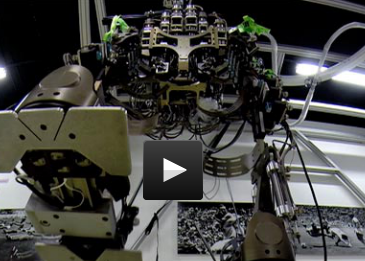Category Archives: Research Highlights
LONG-TERM REHABILITATION USING BRAIN-MACHINE INTERFACES TRIGGERS PARTIAL NEUROLOGICAL RECOVERY IN CHRONIC PARAPLEGIC PATIENTS
On June 12th 2014, the Walk Again Project (WAP), a non-profit international research consortium, performed a unique scientific demonstration, during the opening ceremony of the Soccer World Cup in Brazil. During that demo, a young Brazilian man paralyzed from his … Continue reading
DR. MIGUEL NICOLELIS NAMED RECIPIENT OF 2017 IEEE DANIEL E. NOBLE AWARD FOR EMERGING TECHNOLOGIES
Dr. Miguel Nicolelis was recently selected as the recipient of the 2017 IEEE Daniel E. Noble Award for Emerging Technologies for his “seminal contributions to brain-machine interfaces.” This prestigious award is presented annually for “outstanding contributions to emerging technologies recognized … Continue reading
FOREIGN POLICY ANNOUNCES DR. MIGUEL NICOLELIS AS A LEADING GLOBAL THINKER OF 2015
This year scientists made significant discoveries about the least understood part of the body: the brain. Three labs, in particular, began to unlock the organ’s extraordinary potential — developments with implications for medical advancement and human behavior. At one, Duke University neuroscientist Miguel Nicolelis was able to sync the brain activity of monkeys so they could collectively accomplish tasks, such as move an avatar arm. Continue reading
NEUROSCIENTISTS DEMONSTRATE OPERATION OF THE FIRST NETWORK OF BRAINS (BRAINET) IN BOTH PRIMATES AND RODENTS
Neuroscientists at Duke University have introduced a new paradigm for brain-machine interfaces that investigates how the brains of two or more animals (either monkeys or rats) can be networked to work together as part of a single computational system to … Continue reading
Dr. Nicolelis publishes new book “THE RELATIVISTIC BRAIN: HOW IT WORKS AND WHY IT CANNOT BE SIMULATED BY A TURING MACHINE”
In this monograph, a mathematician and a neurobiologist join forces to address one of the most crucial and controversial scientific questions of our times: can the exquisite capacities of the human brain be simulated by any digital computer? By combining … Continue reading
Grand Challenge Scholar and Nicolelis Lab undergraduate student, Kevin Mauro, interviewed for White House Office of Science and Technology’s Brain Initiative blog.
Duke University Pratt School of Engineering student Kevin Mauro was recently selected for an interview on the Office of Science and Technology’s blog site, to not only promote the NAE’s Grand Challenge Scholar program but also the President’s BRAIN Initiative. … Continue reading
Primate Study Confirms Efficacy of Electrical Stimulation of the Spinal Cord as Potential Therapy for Alleviating Parkinson’s Motor Deficits: Treatment Could be Simple, with Long-Term Efficacy
A study in monkeys, carried out at the Primate Center of the Edmond and Lily Safra International Institute of Neuroscience of Natal, a Brazilian research institute, has demonstrated that electrical stimulation of the spinal cord can relieve a broad range … Continue reading
News from The Walk Again Project
June 12, 2014 Sao Paulo, Brazil – Walk Again Project Demonstration is Carried out Successfully. The Walk Again Project took its first big step today during the opening ceremony of the World Cup: in Corinthians Arena, alongside Miguel Nicolelis, members of the research team and the other seven patients who participated in the clinical trials, Juliano Pinto, a 29-year with complete paraplegia of the lower trunk and lower limbs, gave the symbolic kickoff at the World Cup, wearing an exoskeleton controlled by his mind. Continue reading
The Director of NIH, Dr. Frances Collins, visits Dr. Miguel Nicolelis at Sao Paulo lab where research is being completed for the Walk Again Project demonstration.
SÃO PAULO – Em sua primeira visita ao Brasil, o homem mais poderoso da saúde mundial, o americano Francis Collins, foi ver de perto ontem — e achou “incrível” — o exoesqueleto que fará com que um jovem paraplégico brasileiro … Continue reading
Prototype neuroprosthetic enables wireless recording of 2,000 neurons across multiple cortical areas
This manuscript describes a novel approach that integrates state-of-the-art microelectrode cubes that can record, for the first time in the literature, from volumes of cortical tissue, a large scale wireless transmission system for over-the-air transmission of these signals, and the … Continue reading







 Listen to the interview
Listen to the interview






